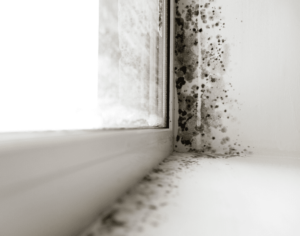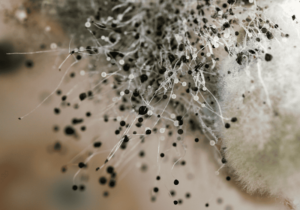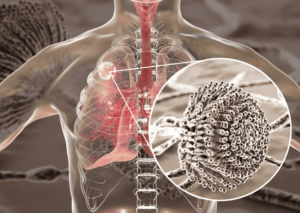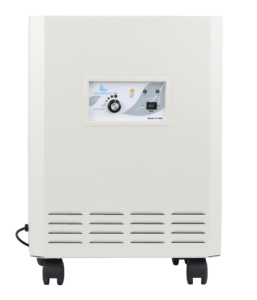Black Mold vs Toxic Black Mold
There can be many scary things that are harbored within the inside of a home, and some of these scary things may come as a surprise to homeowners – especially when they learn that many of these risks can be found in their indoor air. It is becoming a more frequent discussion about the potential dangers that may lurk within the indoor air quality of a home, especially as reports and testing have been conducted that have deemed indoor air quality in many cases more toxic than that of outdoor air – a surprising conclusion to many people! According to the Environmental Protection Agency (EPA), Americans spend on average approximately 90 percent of their time indoors, whether that be in their home’s, at work, etc. In these indoor spaces, however, the concentrations of pollutants were found to be often times 2 to even 5 times higher than typical outdoor pollutant concentrations. What could be the cause to this significant spike in indoor air environments, and could there be a more significant underlying cause to these rapid pollutant concentrations, like mold growth?
Mold is a versatile, fast growing fungi that can easily and seamlessly develop within the walls of a home – no matter if it’s during the cold and damp winter months or even during the hot and humid months of summer. Moisture, humidity, darkness, oxygen, and a food source are all mold needs to develop and aggressively spread throughout the indoor space of a home. The many different variations and types of mold species and among these species there are several types of mold that are prone to growing and thriving within an indoor environment – with some of them classified as less hazardous than others. When we think about toxic molds, the first thing that will come to people’s mind’s is toxic black mold, a known dangerous species of mold that is classified by its hazardous effects in an environment. However, is all black mold ‘toxic’, or is there a difference between black mold vs toxic black mold?
In this article we are going to learn more about black mold including what is black mold, the difference between black mold vs toxic black mold, and how can you eradicate black mold from the air of your home!
What is Black Mold
 The topic of mold is usually associated with the well-known species of mold that is referred to as “black mold”. Black mold is a mold species that has a dark green or black appearance, hints the name associated with this mold, however, the most common species of this mold is actually known as Stachybotrys Chartarum. This mold is identified as a toxigenic mold, which means that the mold as it develops and grows in the environment will begin to release toxins into the air of the environment that will ultimately act as irritants that can harm those individuals that are exposed to it that have preexisting health conditions prior to exposure. Mycotoxins are the toxins that emit from black mold, and this occurs when the mold spores eat, grow, and form colonies with other spores, and lead to compromised air quality, human health, and overall environment.
The topic of mold is usually associated with the well-known species of mold that is referred to as “black mold”. Black mold is a mold species that has a dark green or black appearance, hints the name associated with this mold, however, the most common species of this mold is actually known as Stachybotrys Chartarum. This mold is identified as a toxigenic mold, which means that the mold as it develops and grows in the environment will begin to release toxins into the air of the environment that will ultimately act as irritants that can harm those individuals that are exposed to it that have preexisting health conditions prior to exposure. Mycotoxins are the toxins that emit from black mold, and this occurs when the mold spores eat, grow, and form colonies with other spores, and lead to compromised air quality, human health, and overall environment.
Although black mold is one of the only species of mold that is claimed to produce mycotoxins into the environment in which the mold is growing, this has been debunked as there are many other species of mold that can produce these same toxins into the air. According to Medical News Today, most people are under the assumption that black mold is dangerous because of its production of mycotoxins into the air, however, the fact is that all molds are capable of producing mycotoxins from their mold spores, and just because mold is present in the environment it does not necessarily mean that they are producing these toxins.
Black Mold vs Toxic Black Mold
If you have ever had mold growing inside your home that has a noticeable discoloration present on the surfaces of your home, like a wall or ceiling, you may think that you can identify the mold based on its color, especially whether or not its black mold or not. The truth is that just because the mold present in your home has a black appearance, that does not mean that you are dealing with black mold. There are over 100,000 species of mold, and all of these will come in a variety of sizes, shapes, and colors – with many of them taking on a dark appearance like black that may be misidentified as black mold.
There are many different species of black mold, some of which are identified as harmless black mold while the others will be labeled as “toxic black mold”. The species of black mold that people are most familiar with include Cladosporium and Alternaria – both of which are not considered toxic but can aggravate and produce adverse effects to asthma and/or allergy symptoms from exposure to these molds in an indoor environment. Whereas the Stachybotrys Chartarum black mold is the toxic black mold that has been found to be toxic when found in high levels in a confined space of a home, especially as it rapidly grows and develops in the environment
How Long Does It Take for Black Mold to Grow
 The development and growth of black mold within a home can happen seemingly overnight, as homeowners will usually not have the first inclination of this mold’s growth until they see either physical mold growth on the surfaces of their home or if they begin to experience adverse health symptoms that are isolated only when present inside their home environment. Black mold, like any other species of mold, thrives in warm conditions and will feed off of materials that are in high in cellulose and low in nitrogen – which leaves many building materials in a home a great food source for this mold. Typically, black mold will grow in a space in your environment that is out of sight, and hard to detect which will allow the mold to thrive and aggressively spread throughout the environment. Although most molds have the keen ability to grow quickly with a home, black mold is somewhat different, as the mold need a suitable material to be very wet for at least a week before it can begin its growth phase.
The development and growth of black mold within a home can happen seemingly overnight, as homeowners will usually not have the first inclination of this mold’s growth until they see either physical mold growth on the surfaces of their home or if they begin to experience adverse health symptoms that are isolated only when present inside their home environment. Black mold, like any other species of mold, thrives in warm conditions and will feed off of materials that are in high in cellulose and low in nitrogen – which leaves many building materials in a home a great food source for this mold. Typically, black mold will grow in a space in your environment that is out of sight, and hard to detect which will allow the mold to thrive and aggressively spread throughout the environment. Although most molds have the keen ability to grow quickly with a home, black mold is somewhat different, as the mold need a suitable material to be very wet for at least a week before it can begin its growth phase.
According to Moldpedia, while most mold takes only about one or two days to colonize and grow in the environment, toxic black mold will usually need between eight to twelve days to begin its colonizing in the indoor space of a home.
Is All Black Mold Dangerous?
As we discussed previously, there are many different types and variations of black mold, and these different species of mold are highly prevalent in indoor environments like residential homes and commercial buildings. When it comes to the two most common types of black mold, Stachybotrys Chartarum and Aspergillus Niger, each of these molds will produce varying toxins into the environment that can range from acute to severe in many cases.
Stachybotrys Chartarum is a mold that grows and thrives on cellulose-rich building materials in damp environments. This mold will produce several health effects when black mold exposure occurs in an indoor environment, such as skin inflammation, coughing, runny nose, nose bleeds, burning of the mouth or nasal passages, cold and flu-like symptoms, headaches, and general fatigue. Thus, this type of black mold is considered to be a more toxic form of black mold, which makes it more dangerous to human exposure.
Whereas Aspergillus Niger is a species of black mold that can grow in a home and produce less acute health effects compared to Stachybotrys Chartarum. The health effects associated with this type of black mold species can include aggravation to allergies and asthma, and potential infections of the respiratory system.
Can Black Mold Make You Sick
 If black mold is found growing and thriving inside of your home, will this mold likely make you sick upon exposure? The overall concerns that surround mold and exposure to different species of mold in a home, has led to increasing concern about the effects that the mold can contribute to human health. Many healthcare professionals, particularly allergists and immunologists are seeing an increase in patients that have mold-related sicknesses. When mold develops inside of a home, including black mold, it will become toxic to your health as the mold begins to emit mold spores and toxins into the air, such as mycotoxins, that can become ingested into the human body and into the lungs.
If black mold is found growing and thriving inside of your home, will this mold likely make you sick upon exposure? The overall concerns that surround mold and exposure to different species of mold in a home, has led to increasing concern about the effects that the mold can contribute to human health. Many healthcare professionals, particularly allergists and immunologists are seeing an increase in patients that have mold-related sicknesses. When mold develops inside of a home, including black mold, it will become toxic to your health as the mold begins to emit mold spores and toxins into the air, such as mycotoxins, that can become ingested into the human body and into the lungs.
Contact time between an individual and mold spores and toxins produced from black mold can lead to a person becoming sick, especially after continual contact time in the environment. The Environmental Protection Agency (EPA) stated that mold (including black mold) will ultimately produce allergens and irritants into the air, and when exposure to these airborne pollutants occurs either through inhalation or through touching them on surfaces it can cause an allergic reaction that will provoke allergy-like symptoms. Thus, we can answer the question, “can mold make you sick?” with an affirmative yes.
Is Black Mold Airborne?
Many species of mold are known for their abilities to produce pollutants into the airspace of the environment in which it is growing in, leading to the tainting of the indoor air quality and even effects to the health of those individuals exposed to the environment. Mold spore and toxins like mycotoxins are the two forms of pollutants that are released from mold and that become airborne into the airspace of a home where the mold is growing, each of these pollutants will have varying impacts on the conditions in the space. Black mold is known to produce both of these pollutants into the air, but when these mold spores and toxins are produced into the air it will depend on a number of factors in the environment.
Black mold has a wet coating colony that will typically help to prevent the spores of this mold from becoming airborne into the air space. However, once this moisture source depletes the toxic black mold colony will dry out and promote the releasing of these mold spores into the air. In addition, alterations to the humidity of a home can also trigger the emission of black mold spores into the air of the environment. Lastly, when black mold is disturbed – usually through the process of trying to remove the mold from the environment, it can cause an outbreak of mold spores and toxins that will be released into the air and lead to a toxic indoor air space within the home. Therefore, if you have black mold in your home be sure to contact a mold remediation specialist to properly mitigate and remove the mold source safely from the environment.
Black Mold Air Purifier
Have you started to experience health symptoms only when inside the indoor space of your home? Anything from sneezing, coughing, irritated eyes, nose, and throat, and even general fatigue that all stay with you from the moment you enter the home until you leave it. If this starts to occur then mold exposure could be the culprit behind your growing health issues, and ultimately will mean that the indoor air quality in your home has become compromised by the growing mold, its mold spores, and potential toxins that it may be producing into the air. The best way to help mitigate the potential airborne black mold spores and toxins is through the use and integration of a high-quality air purifier. An air purifier is designed to filter the indoor air of an environment by taking in the air and running it through a filtration technology to pull out and remove certain airborne pollutants from the air. However, not all air purifiers provide the capability to remove small mold spore and toxins from the air, and thus it is important to do your research prior to buying and using an air purifier for black mold removal.
 The EnviroKlenz UV Air Purifier is a revolutionary air purification device that specifically works to filter out mold spores and other microorganisms from the air and provides these airborne pollutants with a high efficiency of kill. The EnviroKlenz® technology is a patented earth mineral non-toxic material that works safely to capture, contain, and neutralize a broad spectrum of noxious and toxic chemicals and odors from the indoor space of an environment. This technology will act as the first stage of filtration in the EnviroKlenz UV Air Purifier, along with a second stage filtration that consists of a hospital-grade HEPA filter for fine particulate matter removal larger than 0.3 microns in size at a 99.99 percent efficiency.
The EnviroKlenz UV Air Purifier is a revolutionary air purification device that specifically works to filter out mold spores and other microorganisms from the air and provides these airborne pollutants with a high efficiency of kill. The EnviroKlenz® technology is a patented earth mineral non-toxic material that works safely to capture, contain, and neutralize a broad spectrum of noxious and toxic chemicals and odors from the indoor space of an environment. This technology will act as the first stage of filtration in the EnviroKlenz UV Air Purifier, along with a second stage filtration that consists of a hospital-grade HEPA filter for fine particulate matter removal larger than 0.3 microns in size at a 99.99 percent efficiency.
What makes the EnviroKlenz UV Air Purifier work solidly against mold spores and microorganisms is its utilization of UV-C light bulbs within the air purifier, and these lights are strategically located in between the two stage of filtration in the air purifier – shining right above the HEPA filter. The HEPA filter will be the filtration process that captures these mold spores and toxins that are collected in the air purifier, and thus the UV-C lights will shine on the collection site of this HEPA filter to effectively destroy the mold spores held within this filter.
Article Sources:

UV Mobile Air System

✓ Patented earth mineral technology works to attack VOCs and break them down on a compound level
✓ No chemicals or masking agents
✓ Will not release any chemicals back into your environment
✓ UVC lamps are continuously shining on the collected organisms with high effeciency of kill and destruction
EnviroKlenz® Medical Disclaimer:
“Any information that is provided on this website is not for the use by any commercial or personal entity without expressed written consent of the blog author. The material and statements illustrated within this blog are not intended to diagnose, treat, cure, or prevent any diseases or medical conditions. Nor does the author in any way guarantee or validate the validity, totality, or efficacy of any claims and will therefore not be held responsible for the content of any claims. Always consult your medical physician for any specific medical advice or recommendations.”
Comments
Post a Comment